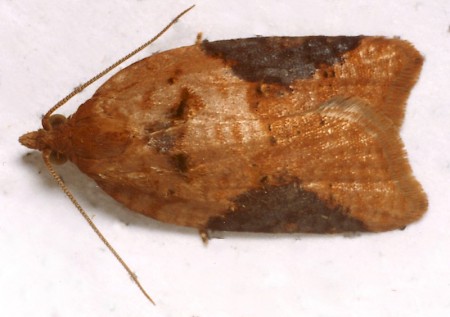
49.066 BF1038
Acleris laterana
(Fabricius, 1794)
Wingspan 15-20 mm.
Another variable species, which is difficult to separate from A. comariana.
A rough guideline is the flight period, which is said to be August to September in the present species, and June/July and October/November in comariana. However, these do overlap and genitalia dissection is usually required to be certain.
The species is generally common and widespread throughout much of the British Isles. The larva, which can be clearly distinguished from A. comariana in later instars, feeds in May and June on Rosaceous trees and shrubs, Salix and Vaccinium.
- More details (Description: Ian F. Smith):
Larva: Foodplant: May and June in spun leaves and flowers of Crataegus, Prunus, Rosa, Rubus, Sorbus, Spiraea, Salix and Vaccinium. Early instar in disproportionately large spun shoot. Later in single folded or rolled leaf.
Early instar: Length: 2.5 mm. Head: black. Prothorax (T1): Prothoracic shield pitchy black. Thorax (T2&T3): Brownish orange. Darker than abdomen. Thoracic legs: Grey-black. Abdomen: Yellowish white. Dorsally the gut shows whitish orange. (A 4 mm specimen showed a leaf green gut). Spiracles: Concolorous with integument. Pinacula: Concolorous with integument. Setae: Transparent colourless. Anal plate: Yellowish white, slightly tinted light grey. Prolegs: Translucent, concolorous with integument.
Intermediate instar: Length: 10 mm. Head: Mid-brown with dark brown marks on capsule. Pitchy black postero-lateral spot. Prothoracic shield: Mid-brown with dark brown at sides and along posterior edge. Divided by light brown fine medial line. Thorax (T2&T3): Whitish, dorsally tinted straw. Thoracic legs: Whitish translucent. Abdomen: Whitish translucent. Dorsally darkened by brownish gut showing. Spiracles: White. Pinacula: Concolorous with integument. Setae: Whitish translucent. Anal plate: Concolorous with body. Prolegs: Concolorous with body, translucent.
Late instar: Length: 17 mm (11 mm specimens, similar but paler). Head: Capsule shiny light brown. Stemmatal area and postero-lateral spot pitchy brown. Labrum dark brown. Clypeus and base of antenna white. Prothoracic shield: Transparent tinted light brown, showing colours of head and abdomen. Distinct pitchy brown sub-triangular postero-lateral mark. Thorax (T2&T3): Coloured as abdomen, but lacking dark dorsal line. Thoracic legs: Translucent whitish. Abdomen: Whitish grey or whitish green, faintly shagreened. Dorsum much darker than sides and venter. A transparent dorsal line shows the viscera as a dark green or dark grey line in segments A2 to A8, often with a break at the junction of A7 and A8. Spiracles: White. Pinacula: Concolorous with integument. Those above spiracle level are discernable because they lack the shagreening of the integument. Setae: Translucent whitish. Anal segment: Anal plate coloured as abdomen, with transparent marks showing dark viscera. Seven pronged anal comb, translucent light brown with dark brown band on each prong distally. Prolegs: Translucent concolorous with integument.
Similar species: The late instar larva of A. laterana can be distinguished from that of A. comariana . Early and intermediate instars may be similar. Diagnostic features, (A. comariana in brackets): Prothoracic shield: Pitchy brown sub-triangular postero-lateral mark. (Blackish brown posterior margin). Pinacula: Concolorous with integument. (brown). Foodplants: Use as guide only. For A. laterana see above. (A. comariana: Potentilla palustris, Fragaria vesca, Geum rivale and, possibly, Azalea and Rhododendron). Details for A. comariana based on Bradley, J.D., Tremewan, W.G. and Smith, A. 1973. British Tortricoid Moths. London.

 UKMoths
UKMoths 








